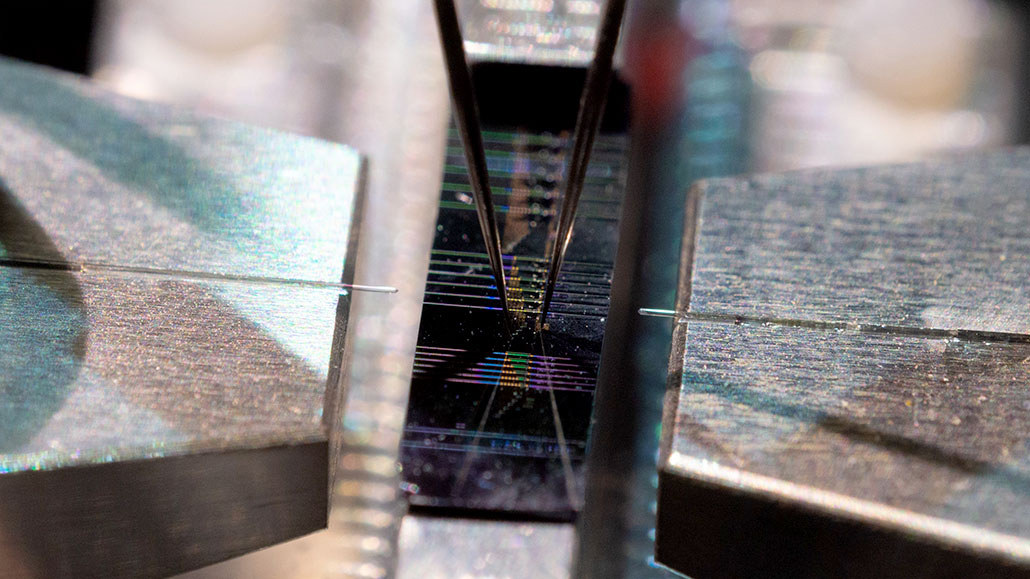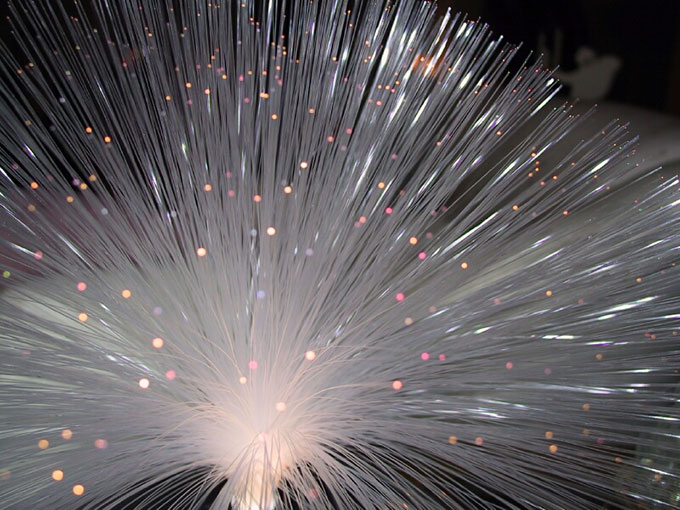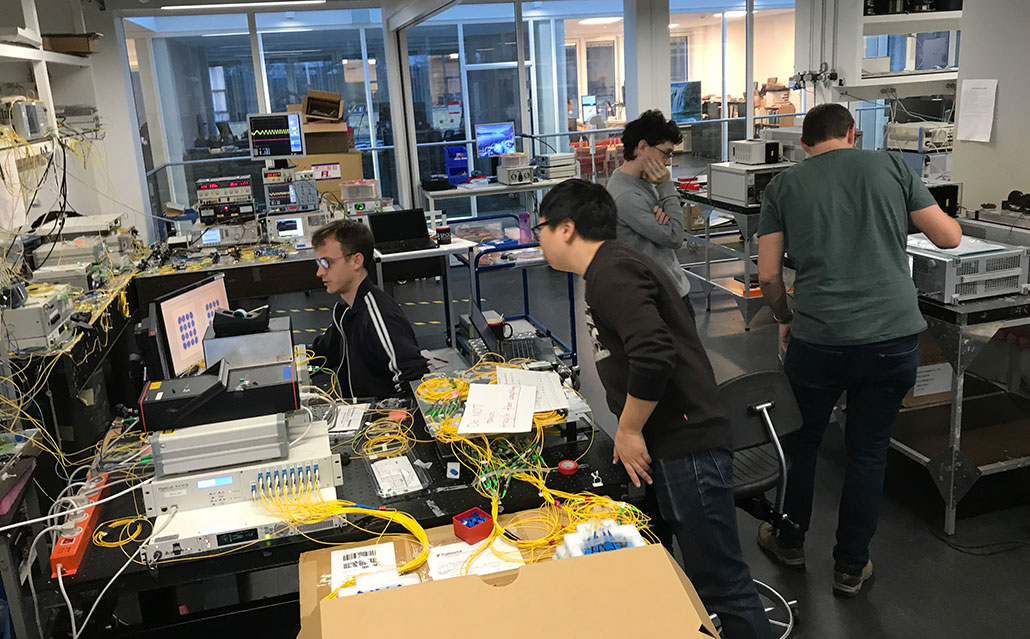A single chip like this could transmit a world’s worth of data
Such tech could help reduce the climate impact of the internet

This chip (center) channeled enough light to carry 1.84 petabits of data per second. That’s about twice the volume of data currently zipping around the world every second as people use the internet!
Julian Curry Robinson-Tait
Researchers have just set a new record for data transmission. Using one small computer chip, they moved 1.84 petabits of data per second. That equals 122 million Netflix movies streaming at the same time.
“We have transferred all of that at once,” says Asbjørn Arvad Jørgensen. He is a physicist affiliated with the Technical University of Denmark and also the University of Copenhagen.
That’s truly impressive, notes Bill Corcoran. Previously, such a feat would have taken many chips and consumed far more energy. Corcoran is a physicist at Monash University in Melbourne, Australia. He was not involved in this research. But he knows a lot about this field. Since 2020, his group had held the record for the highest data-transmission rate using a single chip.
“It’s great to see records being broken at this pace,” Corcoran says.
The Danish team reported its new feat in Nature Photonics on October 20, 2022.
These researchers took advantage of a special phenomenon of light called an optical frequency comb. To make one, you take a laser and shine it through a special chamber. Out pops a carefully crafted rainbow, with all of its colors spaced out evenly. “My 6-year-old son calls these rainbow lasers,” says Corcoran.
The researchers who first figured out how to turn laser light into this special type of rainbow shared the 2005 Nobel Prize in physics. But their technique relied on large machines, “the size of a double bed,” says Corcoran.
In 2007, Tobias Kippenberg was part of a team that figured out how to do the same thing using tiny chips. Rainbows produced this way are now called microcombs. Kippenberg works at the Swiss Federal Institute of Technology Lausanne. This discovery was “rewarding and exciting,” he says. Back then, he adds, “I would not have dreamed of the field as it is today.”
Microcombs can act like tiny rulers to help make extremely precise measurements. Scientists are using them to detect diseases, learn about planets outside our solar system and build more precise clocks. And of course, microcombs can improve digital communications.
How light carries data
When a device connects to the internet, signals zip back and forth. In many cities and towns, these signals travel along fiber optic cables, or “light pipes.” Made of glass, these extremely narrow pipes move data as pulses of light.
Here’s how. A laser shines through a device called a modulator. The modulator converts packets of data from their digital form into patterns of light. Then it manipulates the laser’s light to create these patterns. One pattern might involve turning on and off rapidly. The patterns then zip along the fiber at the speed of light. At the other end, a receiver converts them back into digital data.

Most fiber optic cables have just one core — a single pipe through which that light can travel. To send a lot of data at once, you have to fit multiple beams of light into that one pipe. To travel together without jostling and messing up each other’s data, the light beams must have unique wavelengths. In other words, they must be different colors.
Usually, you need separate lasers to generate each color. Systems using this technique today may operate 80 different lasers at once.
Microcombs have made it possible to replace all those different lasers. Now, a single laser shining into a special type of chip will split into many different wavelengths. This happens because the light travels around a tiny ring made of a special material. The properties of this material only let light escape at certain, evenly spaced wavelengths.
The ring that Jørgensen’s group used created a whopping 223 different wavelengths — or a rainbow of 223 colors! You can’t see them, sadly, as each color is in the infrared range.
But the Danish group didn’t stop there. They also used a new type of fiber optic cable that contains 37 cores. That means a single cable has 37 separate pipes inside. Each can carry the same wavelengths as the others without interference. So the team started with 223 different colors, then split each color 37 ways. The grand total was 8,251 different beams of light. Each beam got sent through a modulator that manipulated the light to carry data.
In a real data center, this technique would require 8,251 separate modulators. Since these devices are expensive, the team made do with just three. The modulators repeated the same sets of data over and over. But they did this in such a way that they could prove that non-repeating data from thousands of modulators would also transfer data correctly.
In their new demonstration, the 8,251 beams of light carried more than an entire world’s worth of data. For this test, the data traveled 7.9 kilometers (4.9 miles) along the fiber optic cable.
The future of data
Of course, all of the data of the entire world’s internet never needs to travel along a single cable. In fact, no single supercomputer today can even generate 1.84 petabits per second. That’s another reason the researchers had to copy the data for their tests.
Even though no one needs to move data so quickly right now, researchers are planning ahead. “We take the long view,” says Bill Corcoran. Looking 10 years out, he says, some links between cities or countries may require petabit-scale rates of data transmission.
Such a high rate may be useful in data centers even sooner, says Jørgensen. And, he says, the 8,251 beams of light could potentially be dispersed in different directions from one chip. So one chip could support many light pipes.

Work still needs to be done before the new device can be put into real-world use. For one thing, engineers still need to find a way to combine many modulators on one platform, says Corcoran. The number of modulators needs to match the number of light beams produced. Imagining thousands of modulators on a chip is tough right now. Even 100 would be “an amazing advance,” he says. Still, the new research is important because of the “energy and cost savings” it promises, says Corcoran. The new technology uses fewer lasers than current methods. That makes it more energy efficient.
Right now, the internet gobbles lots of electricity. At the same time, data usage keeps increasing sharply. And the energy needed for difficult computing tasks such as cryptomining and training artificial intelligence systems already poses a risk to climate. The new innovation in moving data could help keep electricity usage from increasing as steeply as data usage. And that could help lessen the internet’s climate impact.
This is one in a series presenting news on technology and innovation, made possible with generous support from the Lemelson Foundation.







